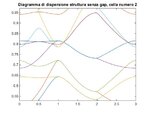pitchoh
Newbie level 3
Hi all I'm new to the forum,
I'm working on my final bachelor thesis and I'm supposed to draw the dispersion diagram of a structure composed by two infinite parallel PEC planes filled with PEC cylinders arranged in an Haxagonal lattice.
This Structure PBS is supposed to present a pair of Dirac Cones at the K symmetry point of the Brillouin Zone, but none of my simulations seems to go even close to this point. I'm working with CST, and I tried several cells, is there something I'm doing wrong? Is it possible that CST isn't able to resolve non-squared geometry periodic structures? I'm very concerned...
the results I should obtain are the ones in fig 1.b in "guiding electromagnetic waves around sharp corners: Topologically protected Photonic Transport in Metawaveguides" by Tzuhsuan Ma.
I post the last unit cell I've tried to simulate.
View attachment dispersionnew.zip
EDIT: The results obtained to this point are the ones in figure where "1" stays for K point and "2" stays for M point:

Thanks to all
I'm working on my final bachelor thesis and I'm supposed to draw the dispersion diagram of a structure composed by two infinite parallel PEC planes filled with PEC cylinders arranged in an Haxagonal lattice.
This Structure PBS is supposed to present a pair of Dirac Cones at the K symmetry point of the Brillouin Zone, but none of my simulations seems to go even close to this point. I'm working with CST, and I tried several cells, is there something I'm doing wrong? Is it possible that CST isn't able to resolve non-squared geometry periodic structures? I'm very concerned...
the results I should obtain are the ones in fig 1.b in "guiding electromagnetic waves around sharp corners: Topologically protected Photonic Transport in Metawaveguides" by Tzuhsuan Ma.
I post the last unit cell I've tried to simulate.
View attachment dispersionnew.zip
EDIT: The results obtained to this point are the ones in figure where "1" stays for K point and "2" stays for M point:

Thanks to all
Last edited:

